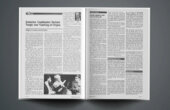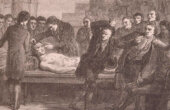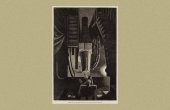The Long History of the Human Aura

Although few of us have ever seen an aura with our own eyes, we all seem to know more or less what it is supposed to look like: a faintly luminescent cloud or haze, a ring of flames, a solar disk, a crown of lightning. These are some of the many ways that artists, healers, clairvoyants, and occult seers at different times and places have visualized physical bodies or body parts as encased within some sort of radiant energy or force.

While not always traveling under the same name, the aura figure has in fact enjoyed a remarkable historical and cross-cultural reach. It has long been available as an artistic device used to mark the presence of deities, saints, emperors, and other specially endowed persons. It has taken shape in anatomical illustrations and diagrams representing the vital forces that are said to constitute our “subtle” physiology. And it has materialized in patterns of light registered on photographs, which are understood to reveal the contours of mysterious energy fields lying hidden in the very fabric of the universe. Folded into its diverse artistic, religious, scientific, therapeutic, and commercial enterprises, the aura figure seems as old as it is ubiquitous. One of its best-known commentators, Walter Benjamin, went so far as to suggest that auras “appear in all things.”
Folded into its diverse artistic, religious, scientific, therapeutic, and commercial enterprises, the aura figure seems as old as it is ubiquitous.
Of course, Benjamin was speaking allegorically, not offering a literal description of the aura. Yet as it happens, our very ability to draw a line between literal and allegorical talk about auras rests on a decisive turn that only occurred in the more recent history of the aura’s long career.
During the late 19th and early 20th centuries, an unprecedented effort was undertaken to investigate the credibility and plausibility of the aura, alongside other phenomena that confounded available naturalist explanations. The outcome of such efforts, roughly stated, was the consolidation of a monopoly opinion among scientific authorities that auras do not really exist in the natural world. Henceforth, their existence could only take the form of cultural constructions, figments of the imagination, pseudoscientific distortions, or technologically induced special effects.
And yet, despite the considerable force of this consensus, efforts to picture auras have only grown, not abated. As I document in some detail in “Picturing Aura,” successive generations of actors have in fact been busy at work adopting and adapting evolving instruments, techniques, platforms, institutions, and markets in their ongoing efforts to capture the aura, penetrate its mysteries, and extend its visible presence.

Some readers will rightly want to know, first of all: What exactly is an aura? Let me begin with an illustration. The image above was originally published as the frontispiece to “The Human Aura: A Study,” a late 19th-century treatise penned by Auguste Jean Baptiste Marques, a medical doctor, diplomat, and erstwhile General Secretary of the Aloha (Hawaii) Branch of the Theosophical Society. Here we see the silhouette of an upper torso and head of what is presumably an “ordinary” human body. Around it is placed a series of colored, cloudlike arches, each of which appears to be wider and more translucent than the previous one. According to the text along the bottom of the panel, these arched layers cincturing the silhouetted body figure are assigned names derived from various Buddhist and Hindu Tantric idioms, such as the “kamic sheath,” while the outermost layer, encompassing all the others, is named the “auric egg.”
The author warns the reader that the width of these layers is not proportionally precise; their relative scale has been adjusted in order to fit onto the page. When taken diagrammatically, however, this illustration establishes the contours of a life-form that does not exactly begin or end where we might normally suppose — at the surface of the skin — but rather somehow extends beyond it. This gradually dissipating, ever-more translucent terrain “beyond” the physical body demarcates the realm of the aura.
Theosophists like Marques played a key role in the consolidation of a particular way of conceiving of the aura as a “subtle, invisible essence or fluid that emanates from human and animal bodies and even things,” which has dominated our understanding of this phenomenon down to the present day. Nevertheless, neither the word aura nor this double figure of a body and its radiant extension are Theosophical inventions. Both can be discovered, time and again, within what turn out to be very long lines of transmission through which devotees, healers, clairvoyants, synesthetes, and other gifted seers across history have reported their perceptions of auras and have attempted to describe what they saw.
Long before Theosophists or any other modern writers turned to the topic, these testimonials were recorded, reproduced, pictorialized, and interpreted within long-standing traditions of art, science, medicine, and cosmology that lent stability to the aura figure in its many local settings as well as in its far-reaching traffic. It is therefore not coincidental that the image presents us not only with an illustration of “the aura” but also a series of descriptive terms, emphasizing the impossibility of separating perceptual experiences from the discursive as well as figural frameworks in which they are entangled. Visualizing an aura implies that one is first able to recognize its shape and apply its name.
But why aura, of all names? Some clues are offered by the history of the word itself, which derives from the ancient Greek αὔρα, the term for a gentle breeze, an aroma, a breath, or an exhalation or emanation of some sort. According to Greek mythology, Aura was a fleet-winged nymph, one of the daughters of Boreas, the god of the north wind. Swift yet gentle in her movements, Aura personified the very notion of a subtle apparition. It is not surprising, therefore, that her name could eventually be applied to such things as the aroma of a perfume, the arrival of a humor descending on a living body, or the mysterious circles of light surrounding angels, gods, emperors, and other extraordinary beings.
One prominent use of the word can be found in Western medical discourse, beginning with the second-century CE Greek physician Galen’s description of the onset of epileptic fits that sweep over the body, a reference that is preserved in the contemporary medical term, aura epileptica. In all these cases, the tropes of gentle breezes, aromas, and hazy yet luminous emanations invoke things that somehow stand between the grossly physical and the incorporeally spiritual: a rarefied dimension of reality or a tertium quid that defies the strict Platonic-Cartesian distinctions of body and mind, matter and force, or substance and idea.
The second-century CE Greek physician Galen used “aura” to describe the onset of epileptic fits — a meaning still preserved in aura epileptica today.
When applied to the living body, as Marques does in his own illustration, the word aura seems to designate a nearly imperceptible boundary that extends beyond while also hovering around the physical body. In “The Book of Skin,” Steven Connor offers a more recent definition of the aura as an ethereal exoskeleton: a second skin that, like a shadow, is “conceived not as a separate entity that is capable of existence apart from the body.” At once liminal and permeable, forever forming and re-forming itself, this gentle breeze entangles bodily interiors and exteriors within a unity that cannot be dissected or divided any more than one can cut air with a knife.
The rarefied qualities conjured by the word aura have often invited comparison with other figures and terms that likewise seem to break down the barriers of inner and outer, or of material and immaterial. Sometimes invoked through metaphors of vapor or wind, at other times couched in the language of glowing lights, clouds, diaphanous tissues, or refined particulates (such as stardust), this subtle presence has been assigned many names, among them: pranamayakośa, sūkṣma śarīra, qi, ochêma-pneuma, archeus, lumière astrale, perianto, force vitale, psychotronic vibrations, and bioplasma. In their aggregate, they throw into relief a long-standing preoccupation shared among diverse metaphysical traditions, sciences, and knowledge systems, from Neoplatonism to Tantric Buddhism, from Romantic Naturphilosophie to traditional Chinese medicine.
No less influential a figure than Aristotle attempted to address the problem of body/soul (or body/mind) dualism by proposing the existence of a mediator, the phantasmic pneuma: a thin casing surrounding the soul, composed of the same refined substance as the stars, which the philosopher understood to enable that soul to come into contact with the sensory, material world. Working in this Aristotelian framework, medieval Christian theologians such as Thomas Aquinas expounded at length on all manner of things that seemed possible only by virtue of a subtle intermediation between the physical and the spiritual: from the vitalizing warmth of human breath to expressions of friendship and mutual affection, to the agitation of the emotions provoked by the sight of stunning beauty.
For their part, the Renaissance Hermetic “natural magicians” — Marsilio Ficino, Paracelsus, Giordano Bruno, among others — turned to Neoplatonist philosophy for a language that could account for some such pneumatic, subtly mediating figure, which in their understanding linked physical bodies to a vast cosmic network of invisible forces of attraction and repulsion emanating from the planets and the stars. Comparable accounts of an intermediary range of gradations between matter and spirit, body and soul, or between the terrestrial and the celestial, can also be found in numerous non-Western textual, ritual, and medical traditions, including, for instance, the Hindu doctrine of the “third body” (the sūkṣma śarīra), first mentioned in the Upanishads and later taken up as a key theme in Sāṃkhya and Vedānta philosophy and in the practices of yoga and Tantra.

While each of these accounts of auras and aura-like phenomena can be located in its distinct historical and cultural context, it is hard to resist the temptation to collate them into a more general picture. In recent years, a number of scholars have adopted a cross-cultural comparative framework with the precise intention of establishing continuities among practices, concepts, and objects — including the aura — under the rubrics of “subtle matter” and “the subtle body.” Within this framework, the word subtle designates a family of (at least partially) overlapping orientations and perceptions, experiences, techniques, vocabularies, imaginal resources, and knowledge claims elaborated in diverse historical and cultural contexts. However, this search for a general category, even when adopted strictly as a methodological heuristic, partakes in a much longer and more vexed history.
For more than a century, perceived commonalities among diverse Western and Eastern metaphysical traditions have nourished a vibrant tradition of scholarship on comparative religion, just as they have inspired popular writers to fill the “esoterica” section of retail bookstores and, in more recent times, New Age websites, with all manner of wisdom on the cosmic harmonies that are said to bridge the world’s religions, spiritual practices, and enlightened sciences. The classificatory schemes that many present-day scholars, as well as popular writers, rely upon in their general descriptions of such things as “the subtle body” or “the aura” are in fact patterned directly on the prior work of occultist and esoteric writers — Theosophists foremost among them — from over a century ago.
While as a word, a visual figure, and an idea, the aura seems to have enjoyed a remarkably long history, something distinctive was taking shape in the late 19th and early 20th centuries. One measure of the scale of this shift can be gleaned from the sudden increase in the use of the word in published works in English, French, German, Spanish, and Russian around that time.
According to Google’s Ngram Viewer (a digital tool that charts the frequency of vocabulary appearing in sources printed since 1500), the word aura experienced a dramatic spike between roughly 1890 and 1920 within all these languages. In some cases, such as German and Russian, the word seems to have been almost nonexistent in publications until around 1850, after which its steady growth crests in a veritable explosion of occurrences from the 1890s onward. Here then, roughly speaking, we can mark the birthplace of the modern word aura. One of the most distinctive features of this new usage is a dramatically expanded semantic range: a democratization, so to speak, of a phenomenon formerly reserved for extraordinary bodies and bodily states. In its modern usage, the word aura has been extended across all of creation; to recall once again Marques’s definition cited above, it now references a “subtle, invisible essence or fluid that emanates from human and animal bodies and even things.”

The previous fin de siècle constituted such a decisive moment for this reformulation of the word aura in large part because Theosophists and their fellow travelers were able to take advantage of an unprecedented restructuring of science, technology, religion, and culture during this period. Among them, Theosophist and scholar of esoteric traditions George Robert Stow Mead saw modern science as a tool for uncovering hidden truths about the subtle body. His meditations on the “hitherto undreamed-of possibilities locked up within the bosom of nature” highlight what is in fact a commonplace understanding of the late 19th and early 20th centuries as a moment of dizzyingly rapid and profoundly unsettling scientific and technological change, in which established assumptions about matter, energy, and life were openly challenged, to the great interest of journalists, artists, and many other observers.
As registered in diverse arenas of laboratory experiments, popular science magazines and public demonstrations, stage magic and early cinema, trick photography, Spiritualist séances, and new avant-garde art movements, among many other places, the new sciences generated distinctly new ways of making invisible things present and addressing mysterious, hidden dimensions of the cosmos. In this context, esoteric writers such as Marques and Mead were uniquely positioned to redefine the aura and related phenomena as an object of ancient wisdom and also, at the very same time, as a frontier science research topic.
Over the course of the 20th century and up to the present day, these conjunctions of science and occultism provided the framework within which the modern figure of the aura has been defined, visualized, and worked upon. Conceptually, discursively, and even performatively, the purveyors, practitioners, clients, and engaged audiences of the present-day New Age spiritual marketplace rest on the shoulders of their Theosophical forebears such as Marques and Mead. This is not to deny that the instruments, techniques, experts, and visual materials gathered under the rubric of “picturing aura” have sometimes moved onto terrains far removed from the New Age milieu, strictly speaking.
Nevertheless, no account of the practice can be written without taking into account how this earlier history of entanglement of science and occultism shaped the widely distributed sensibilities, modes of reasoning, and techniques of body care for which the visualization of the aura became so indispensable. From the late 19th century to the present day, this confluence of esoteric vocabularies and concepts, new means of technical picture-making, and protocols of scientific observation set the stage upon which the modern history of picturing aura has unfolded.
Jeremy Stolow is Professor of Communication Studies at Concordia University, Montréal, Canada. Among his publications are the books “Orthodox by Design” (University of California Press) and “Deus in Machina” (Fordham University Press). This article is adapted from his book “Picturing Aura: A Visual Biography.”



